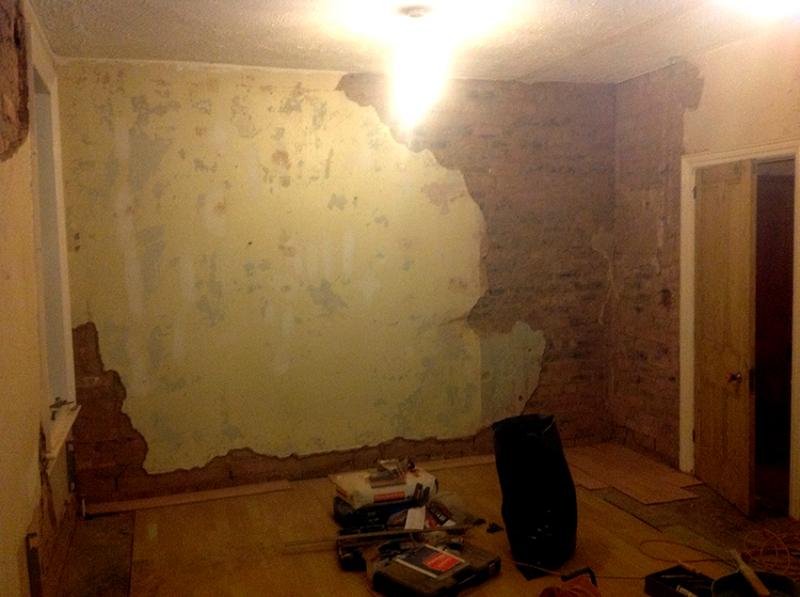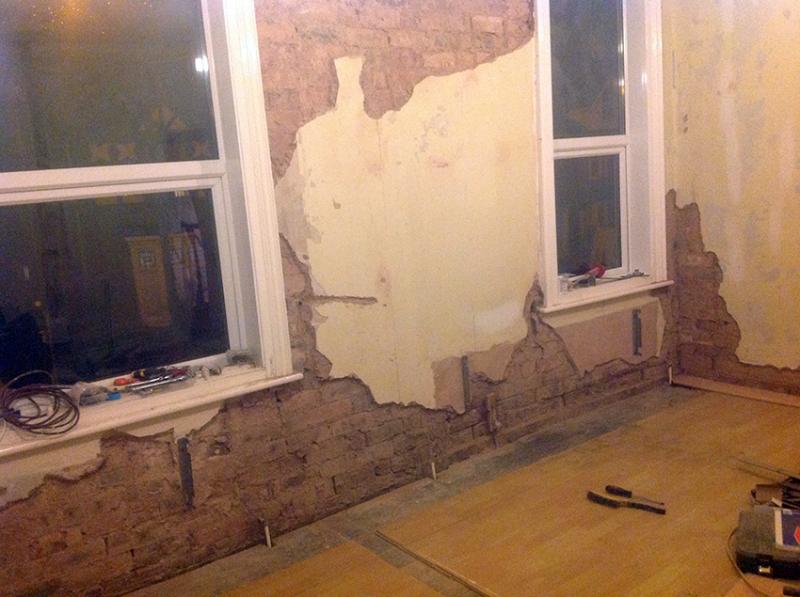Hi all,
I am in a dilemma as to what steps to take next...
I have started a fairly major job this weekend by stripping the walls of any loose plaster before patching it up.
As you can see from the pics there was a fair bit of it!... what a mess.
The house was built in 1908 and has solid external walls. The room is 6M x 4M x 2.75Mhigh. The two walls you are looking at in the pics are external and solid. (no cavity).
My initial plan after speaking to my local plasterer was that I would batten/lath the walls and offer up some insulated board between and then plasterboard over the top. He would then come and skim over them.
I then realised that if I were to screw some battens on top of the plaster, it would need to be relatively sound behind.
I went round the room tapping it with the back end of a screwdriver, anything sounding hollow I pulled off,.. it came off very easily. The one pic shows how the corner was particularly bad, this was because there was once a shower unit in that corner. (previous owner).
The plaster on both of these external walls is about an inch deep.
I was wondering if to patch up what I have done and then carry on applying the battens/laths on top or to carry on stripping the rest of the wall and apply the battens straight onto the bricks?
I was going to use carvers foil backed insulation board
http://www.carvers.co.uk/search.aspx?s=i903465
between the battens and
http://www.carvers.co.uk/search.aspx?s=i756262
to go over the top.
My step father then suggested I would be better using thermalcheck board
http://www.carvers.co.uk/products/P...EXTRUDED-XP-POLYSTYRENE-18-PER-PALLET/P131774
on top of the battens which is a combined polystyrene and plasterboard. He thought I should leave the space behind the 25mm thick battens and screw these boards directly on top, in affect creating a cavity. The only problem with this is, the windows would look strange with the insulation/plasterboard protruding beyond the level of the window edge and sill. Batten 25mm, thermalcheck 55mm + skim.
This problem would still happen using the initial plan, but by no way as far because the insulation was going to be against the wall with no cavity, the damp being protected by the foil backing. I thought I could add to the window some corner beading to disguise the difference.
This scenario would not happen however if I were to take off all the plaster and revert to applying the battens and insulation/board directly on top of the bricks using the first method.
I want to offer some insulation to room, but do not want to make a decision that I end up regretting or create work that is unnecessary. I also do not want to create a more serious damp problem.
This is an upstairs room has three external walls facing north, it has double glazing. There is a room above which is a converted loft.
I have two radiators that need to back onto the walls under the windows.
Your thoughts please would be appreciated.
I am in a dilemma as to what steps to take next...
I have started a fairly major job this weekend by stripping the walls of any loose plaster before patching it up.
As you can see from the pics there was a fair bit of it!... what a mess.
The house was built in 1908 and has solid external walls. The room is 6M x 4M x 2.75Mhigh. The two walls you are looking at in the pics are external and solid. (no cavity).
My initial plan after speaking to my local plasterer was that I would batten/lath the walls and offer up some insulated board between and then plasterboard over the top. He would then come and skim over them.
I then realised that if I were to screw some battens on top of the plaster, it would need to be relatively sound behind.
I went round the room tapping it with the back end of a screwdriver, anything sounding hollow I pulled off,.. it came off very easily. The one pic shows how the corner was particularly bad, this was because there was once a shower unit in that corner. (previous owner).
The plaster on both of these external walls is about an inch deep.
I was wondering if to patch up what I have done and then carry on applying the battens/laths on top or to carry on stripping the rest of the wall and apply the battens straight onto the bricks?
I was going to use carvers foil backed insulation board
http://www.carvers.co.uk/search.aspx?s=i903465
between the battens and
http://www.carvers.co.uk/search.aspx?s=i756262
to go over the top.
My step father then suggested I would be better using thermalcheck board
http://www.carvers.co.uk/products/P...EXTRUDED-XP-POLYSTYRENE-18-PER-PALLET/P131774
on top of the battens which is a combined polystyrene and plasterboard. He thought I should leave the space behind the 25mm thick battens and screw these boards directly on top, in affect creating a cavity. The only problem with this is, the windows would look strange with the insulation/plasterboard protruding beyond the level of the window edge and sill. Batten 25mm, thermalcheck 55mm + skim.
This problem would still happen using the initial plan, but by no way as far because the insulation was going to be against the wall with no cavity, the damp being protected by the foil backing. I thought I could add to the window some corner beading to disguise the difference.
This scenario would not happen however if I were to take off all the plaster and revert to applying the battens and insulation/board directly on top of the bricks using the first method.
I want to offer some insulation to room, but do not want to make a decision that I end up regretting or create work that is unnecessary. I also do not want to create a more serious damp problem.
This is an upstairs room has three external walls facing north, it has double glazing. There is a room above which is a converted loft.
I have two radiators that need to back onto the walls under the windows.
Your thoughts please would be appreciated.



